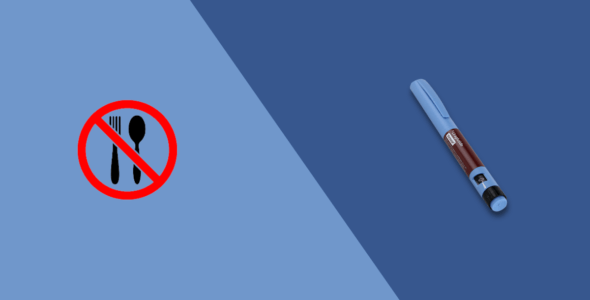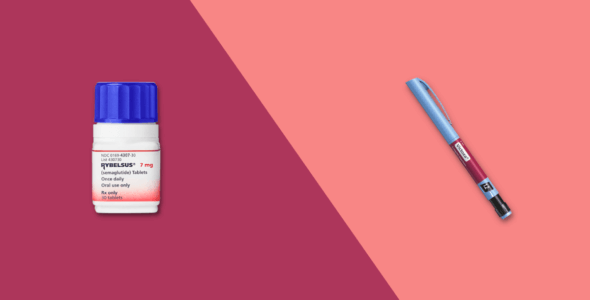Saxenda and Victoza are brand-name prescription drugs both containing liraglutide. Victoza is used to help control type 2 diabetes mellitus, whereas Saxenda can be used as a weight-loss medication.
Here we will explain how they work, their similarities and differences, their side effects, and more. This should provide you with the basics to better understand your options.
What is Saxenda?
Saxenda is an FDA (U.S. Food and Drug Administration) approved medication manufactured by Novo Nordisk Inc. It contains the prescription medicine liraglutide. Liraglutide is similar to a naturally occurring hormone in the body that controls digestion, insulin levels, and blood sugar levels. Saxenda is recommended alongside a reduced-calorie diet and an increase in exercise. It is used to help manage obesity in adult patients with a body mass index (BMI) of:
- 30 kg/m2 or more, or
- 27 kg/m2 or more with a weight-related condition such as high blood pressure, type 2 diabetes, high cholesterol, triglycerides, or a low HDL cholesterol level that is making plaque build-up in your arteries worse
Saxenda is not specifically for the treatment of type 1 or type 2 diabetes or weight loss. Saxenda is part of a treatment plan that will include, diet, exercise, and weight management. GLP-1 is classed as a physiological regulator of appetite and calorie intake. This means it works by a method known as negative feedback. The GLP-1 receptor is seen in several areas of the brain involved in appetite regulation.
Saxenda dosage
Saxenda is available in injection form, at 6 mg/mL and delivers the following doses: 0.6 mg, 1.2 mg, 1.8 mg, 2.4 mg or 3 mg.
Liraglutide is classed as an acylated human glucagon-like peptide-1/GLP-1 receptor agonist. Liraglutide binds to and activates the GLP-1 receptor. Unlike naturally occurring GLP-1 in the body, which has a half-life of up to 2 minutes, liraglutide is stable against breakdown by enzymes in the body and has a half-life of 13 hours.
Saxenda is given as a subcutaneous injection under the skin. It can be given at any time of the day, with or without a meal. You should not inject into the same place two times in a row. If the injection has particles in it or has changed color, do not use it. Speak to your pharmacist about a new medicine. You should dispose of used needles and syringes by using puncture-proof disposal sharps containers. Store unopened pens in the refrigerator. In-use pens may be kept at room temperature for up to 30 days. Always remember to store your medicine out of the reach of children and pets.
What is Victoza?
Victoza is manufactured by Novo Nordisk. It has FDA approval to help control blood sugar levels in people with type 2 diabetes (adult-onset diabetes). Victoza also contains liraglutide. It’s usually prescribed when people can’t control their blood sugar through diet and exercise alone, or if their diabetes medication isn’t effective. Victoza can be used instead of other diabetes medicine, or alongside some diabetes medicines.
Using Victoza may aid weight loss, and help to reduce body weight. This may be especially useful in those patients also suffering from obesity. It can also be used to reduce the risk of cardiovascular events in people who have both type 2 diabetes and heart disease.
When you eat and digest food, sugar is released into your blood so it can be transported around your body. Your body absorbs the sugar out of your blood, returning your blood sugar to normal levels. In people with diabetes, their bodies struggle to control their blood sugar levels. Often their blood sugar is too high, and over time this can cause a range of problems, including nerve damage and heart disease. When injected, Victoza helps people with type 2 diabetes control their blood sugar levels in three ways:
- It helps your pancreas produce more insulin (a hormone that helps your body absorb blood sugar)
- It reduces how quickly food moves through your stomach, slowing down the release of sugar into your blood
- It helps to stop your liver from releasing too much sugar into your blood
Victoza dosage
Victoza is available as a subcutaneous injection, in the following doses: 6 mg/mL. Inject Victoza once daily at any time of day, in the abdomen, thigh, or upper arm. Administer separate injections when using with insulin.
Initiate adult dosage at 0.6 mg daily for one week increasing to 1.2 mg daily. Increase the dose to 1.8 mg daily after one week of treatment with the 1.2 mg daily dose if further glycemic control is needed.
Initiate pediatric dosage at 0.6 mg daily for at least one week. Increase the dose to 1.2 mg daily if further glycemic control is needed. If additional glycemic control is still required, increase the dose to 1.8 mg daily.
Read the full prescribing information and always speak with a healthcare professional for medical advice about any changes to your dose so they can monitor and evaluate your condition.
Common side effects of Saxenda and Victoza
The most common side effects of Saxenda in clinical trials include:
- Nausea, vomiting, and stomach pain
- Diarrhea
- Constipation
- Fast heart rate
- Tiredness
- Headaches and dizziness
More serious side effects of Saxenda include:
- Increased heart rate
- Suicidal thoughts or sudden changes in behavior and mood
- Severe nausea, vomiting, or diarrhea that will not stop
- Hypoglycemia (very low blood sugar levels) – feeling very weak, shaking, confused, sweating, fainting, or seizures
- Pain or difficulty urinating, swelling in ankles or feet, tiredness, and difficulty breathing
- Trouble swallowing, lump, or swollen neck
- Jaundice – yellowing of eyes or skin, darker stools, upper stomach pain spreading to the back
- Increased risk of thyroid cancer
The most common side effects of Victoza in clinical trials include:
- Nausea
- Diarrhea
- Low blood glucose
- Headaches
- Anxiety
- Tremors
More serious side effects of Victoza include
- Inflammation of the pancreas
- Kidney and gallbladder problems
- Increased risk of thyroid tumors and cancer
These aren’t all the side effects Saxenda or Victoza can cause. You can find more details in the patient leaflet that comes with your medication. If you have any concerns about side effects, talk to your physician or pharmacist.
Saxenda and Victoza drug interactions
Saxenda can interact with other medications. These include:
- Antibiotics for bacterial infections such as gatifloxacin
- Bexarotene used to treat skin cancer
- Insulin – aspart, detemir, glargine, lispro
- Oral diabetes medicines – glipizide, glimepiride
- Antiviral medication – amprenavir, atazanavir, darunavir, ritonavir, saquinavir
- Diuretics – bendroflumethaizide, bumetanide, furosemide
- Antibiotics – ciprofloxacin, clarithromycin, norfloxacin
- Corticosteroids – dexamethasone, fludrocortisone, prednisolone
Victoza can interact with other medications. These include:
- Antibiotics for bacterial infections such as gatifloxacin
- Bexarotene used to treat skin cancer
- Any other diabetes medications, like insulin or sulfonylureas
- Diuretics, taken to make you lose water and salt, usually to treat high blood pressure – bumetanide, furosemide
- Corticosteroids such as cortisone and prednisolone
- Beta 2-stimulants, taken to treat asthma – salmeterol
- Estrogen-containing drugs including birth control and hormone replacements
- Steroids used topically (on the skin) such as betamethasone, clobetasol, hydrocortisone, and mometasone
Saxenda and Victoza can interact with other medications. This can change how Saxenda and Victoza and other medications work and can make side effects more likely. Tell your prescribing physician about all your drugs, including vitamins and dietary supplements.
Saxenda and Victoza contraindications
You should not use Saxenda if you:
- Are allergic to the active ingredient liraglutide
- Have had an allergic reaction to any of the other ingredients in Saxenda
- Are using insulin or albiglutide, dulaglutide, or exenatide
- Have multiple endocrine neoplasia type 2
- Have a family history of medullary thyroid carcinoma
- Have diabetic ketoacidosis
- Are under 18 years of age
Talk to your doctor before using Saxenda if you:
- Are taking any of the medications that could interact with Saxenda
- Have kidney disease
- Have liver disease
- Have high cholesterol or triglycerides
- Have heart problems
- Have problems with your pancreas or gallbladder
- Have depression or suicidal thoughts
- Have stomach or digestion problems
- Are pregnant or are planning to become pregnant
- Are breastfeeding or are planning to breastfeed
You should not use Victoza if you:
- Are allergic to the active ingredient liraglutide
- Are allergic to any of the other ingredients found in Victoza
- Have type 1 diabetes or diabetic ketoacidosis
Talk to your doctor before using Victoza if you:
- Have severe heart disease
- Have severe liver disease
- Are on dialysis
- Have a severe stomach or gut problem
- Have inflammatory bowel disease
- Symptoms of acute pancreatitis (like a persistent, severe stomach ache)
- Have thyroid disease
- Are pregnant or are planning to become pregnant
- Are breastfeeding or are planning to breastfeed
Other drugs for diabetes
If you have any concerns about Saxenda or Victoza side effects, talk to your physician, or pharmacist for medical advice. Also inform your healthcare provider about any medical conditions, supplements, and over-the-counter meds you are taking. You are also encouraged to report side effects to the FDA: visit http://www.fda.gov/medwatch or call 1-800-FDA-1088.





